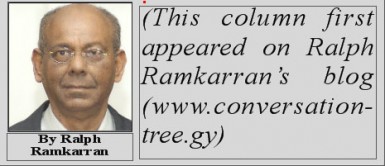The Demerara Slave Rebellion of 1823 was a seminal event in the history of slave resistance in British Guiana and in the colonial world. Its stark exposure, once again, of the horrors of slavery speeded up its demise even as growing anti-mercantilist trends were ravaging its economic foundations. Jack Gladstone was the rebellion’s principal organizer and leading militant. While he has not been forgotten by history, his monumental, though costly, contribution to the abolition of slavery in 1838 and the advancement of freedom is little known. Professor da Costa’s book, Crowns of Glory, Tears of Blood – The Demerara Slave Rebellion of 1823, restores Jack Gladstone’s place in the narrative of resistance, but popular recognition and full knowledge of his role have still eluded his contribution to the freedom struggle.

Rev John Smith, a man of “modest origins,” had himself been an artisan apprentice and had experienced “poverty and privation.” He and his wife Jane arrived at Le Resouvenir in British Guiana in February, 1816, to replace Rev John Wray, by which time the campaign for abolition had attracted much support and was influencing missionaries. He became strengthened in his view about the “helplessness and innocence” of slaves and the “sinfulness and godlessness” of planters after seeing on the journey from the city the hovels of slaves and the manicured lawns and mansions of the planters.
There had been growing tensions between planters and missionaries as a result of a dispute about teaching slaves to read. Planters, including Lieutenant-Governor John Murray, felt that if slaves knew how to read, they would become agitated by the various proclamations and abolitionist writings which were being published. Missionaries felt that it was necessary for the slaves to learn to read so that they could read the Bible. Animosity grew against Rev John Smith to such an extent that immediately after the rebellion, he was indicted with assisting the rebellious when in fact he had no foreknowledge of it and did his best to stop it when rumours became widespread. He was pardoned but died in prison before information about it reached the colony.
Jack Gladstone, probably named after Sir John Gladstone, the father of British Prime Minister, William Gladstone, who had estates in Demerara, was the son of Quamina. He was tall and described in wanted posters after the rebellion as “handsome.” He was a skilled cooper and had several lady friends in several estates. He was deeply intolerant of his condition of enslavement. After word began to spread that new laws ameliorating the conditions of slaves had been made but that the authorities were suppressing them, general agitation spread and Jack Gladstone became incensed. He was determined that the enslaved should not be shortchanged and should receive the benefit of the new laws. Several rebellions had already taken place in the region. Expectations by slaves of better conditions were high.
Quamina was the recognized leader of the rebellion while Jack Gladstone was its principal organiser. He travelled secretly and at night to estates, agitating and encouraging fellow enslaved to rise up. He planned, organised and established teams and systems. His father, Quamina, had been hesitant but came on board later. His prestige added support for the rebellion. He wavered toward the end because of uncertainty as to its success, but still held firm and eventually refused to surrender, walking away with head held high in response to a shout from a soldier to stop. He was shot in the back.
The rebellion along the coast was widespread, involving 9,000 slaves, but astonishingly free of violence. No one was killed and very few were hurt. Planters and their families were treated with great courtesy, even though they were locked up in their homes or elsewhere in the compound as plantations and property were taken control of.
The rebellion collapsed after the militia was deployed. There were some brief firefights but most of the enslaved surrendered. The revenge was swift, deadly and murderous. In the butchery some 225 rebels were summarily executed, innocent as well as guilty, many without trial and some after a brief, perfunctory, trial designed to intimidate. Many who were executed were decapitated, forcibly and tearfully by their fellow slaves and co-workers, and their heads displayed on poles on the estate and elsewhere.
Jack Gladstone was tried and convicted. He revealed details of the plans and implicated Rev John Smith with foreknowledge and the church with sowing dissatisfaction, although the evidence suggests that at least some of the statements regarding the latter were not made by him. The colonial authorities assessed the strength of his character, the depth of his courage and the example of his leadership. They knew that if he were executed he would become a martyr. He was sentenced to deportation and taken to St Lucia where he was sold into slavery. (A longer version of this article was first published in July 2009).





